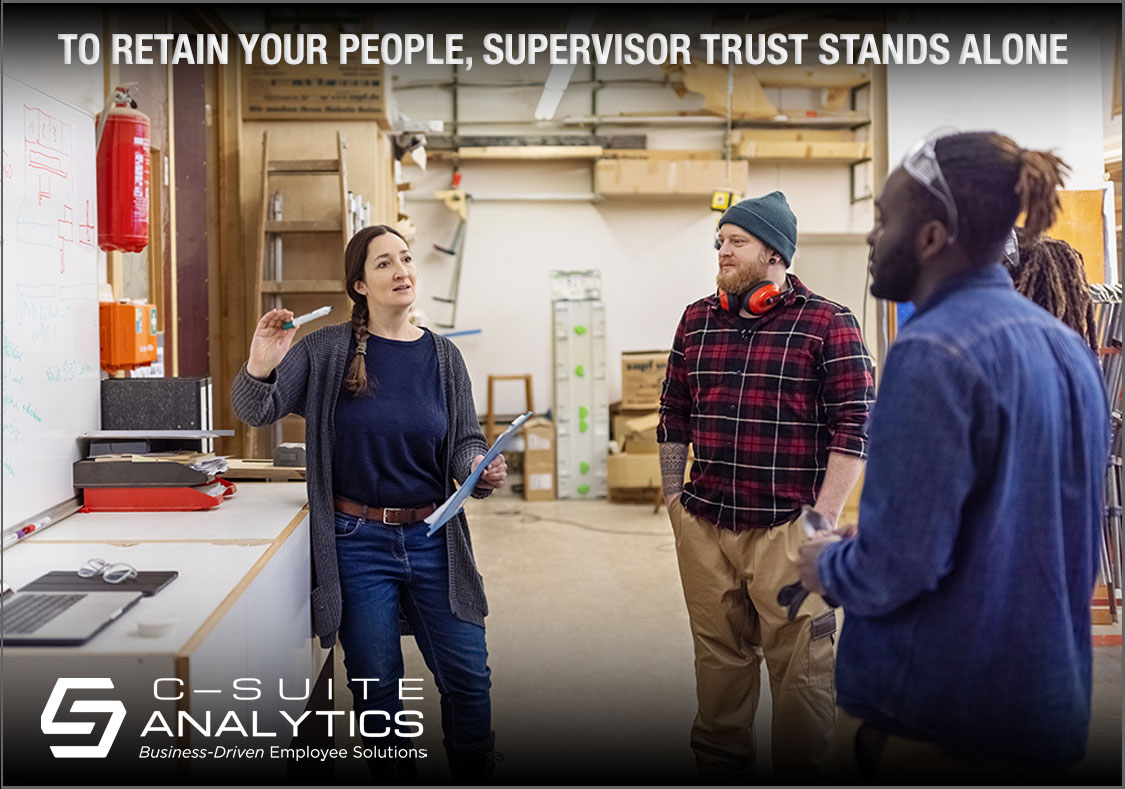Most hiring tools answer whether candidates can and will do the job, but not if they’ll stay. Learn how realistic job previews and motivational-fit interviews can improve retention from day one.
To Retain Your People, Supervisor Trust Stands Alone

It seems trite to say that supervisors who build trust will improve employee retention…more than the traditionally-considered solutions like pay, benefits, onboarding, training, time off, work from home, and everything else. It sounds too simple, too intangible, but it’s true. So true that in my book HR’s Greatest Challenge I summarize 25 such studies, each conducted by either an academic guru or a leading consulting organization.
Manager Relationships Correlates with Employee Retention
With clients we usually cite just one of these studies, conducted by global consulting company Kenexa. Kenexa surveyed 1,000 voluntary quitters across multiple industries and asked their opinions on five variables which were pay, benefits, development, advancement, and their manager. Just one correlation resulted, that the more positively one felt about their manager then the more positively they felt about their pay, benefits, development, and advancement.
The outcome of this and related studies is profound…and redirecting. What it says is the prism or the lens through which your employees see their relationship with their manager is how they see your company. And it mirrors two longstanding Gallup studies: (1) that each supervisor establishes her own company culture which might or might not match the culture your CEO reports to your board of directors, and (2) that supervisors impact a full 70% of the engagement of their teams.
—–
Further Reading: Seven Proofs Managers Drive Retention, Not HR
—–
Accepting that Supervisor Trust Drives Employee Retention
I sometimes say, “you must bite the apple on supervisor trust”. It’s my way of saying you must accept/buy in/pass through a threshold of not just accepting the concept…but you must also radically adjust the solutions you bring to employee retention, as well as to employee engagement. Consider this typical checklist of programs that offer little opportunity for supervisors to build trust:

Two important questions surface from this list:
- What significant thing do you offer your employees that your competition for talent doesn’t also offer?
- Should you continue to offer these things once you bite the apple on trust?
Only you can answer #1…but the important word is “significant” such that your employees who have a jerk boss actually still stay because of that thing. The answer to #2 is “yes” but don’t expect the items on this list to cut turnover.
—–
Further Reading: How Bad Managers Drive Turnover
—–
Supervisor Trust is not the Same as Approachability for Employee Retention
Want another test? Compare supervisors’ turnover percentages against your list of those you believe are best and worst at building trust.
We social scientists long ago determined that the primary, the most important quality in relationships is trust. If you identify in your mind the best and worst bosses you’ve ever had, it’s a sure bet that you trusted the best one and distrusted the worst one. And that the same best boss had shortcomings like didn’t always respond on time or other human failings, but you easily forgave that person because you trusted her. Conversely, your worst boss had strengths…but you were blindfolded to those strengths because that person had consistently broken trust.
Trust is the single go/no go indicator in relationships…yet corporate trainers lump trust in with approachability, communication, recognition, feedback, as though trust has relationship peers. Trust has no relationship peers.
Besides, our brains are built to be emotional before rational. We judge people mainly on how we instinctively feel about them versus what they do for us. Those same brains also react first in ways that are self-protective, so we seek out those who look out for us. We are essentially cave people with a club.
—–
Further Reading: How Can Stay Interviews Build Trust?
—–
Stay Interviews are THE Trust-Builder for Employee Retention
Start with Stay Interviews, the concept I invented more than ten years ago which is designed solely for leaders to build trust individually with each of their direct reports. We train leaders to ask five highly researched questions with four specific skills in order to learn and fix at least one thing that is a day-to-day obstacle to that employee’s work happiness. Our model also includes converting turnover to dollars, developing retention goals, asking leaders to forecast how long each employee will stay…all to provide support such that each leader will retain each employee longer.
Stay Interviews are the star, the interactive keystone to developing leaders to build trust. The outcome is cutting turnover…20% and more.
—–



